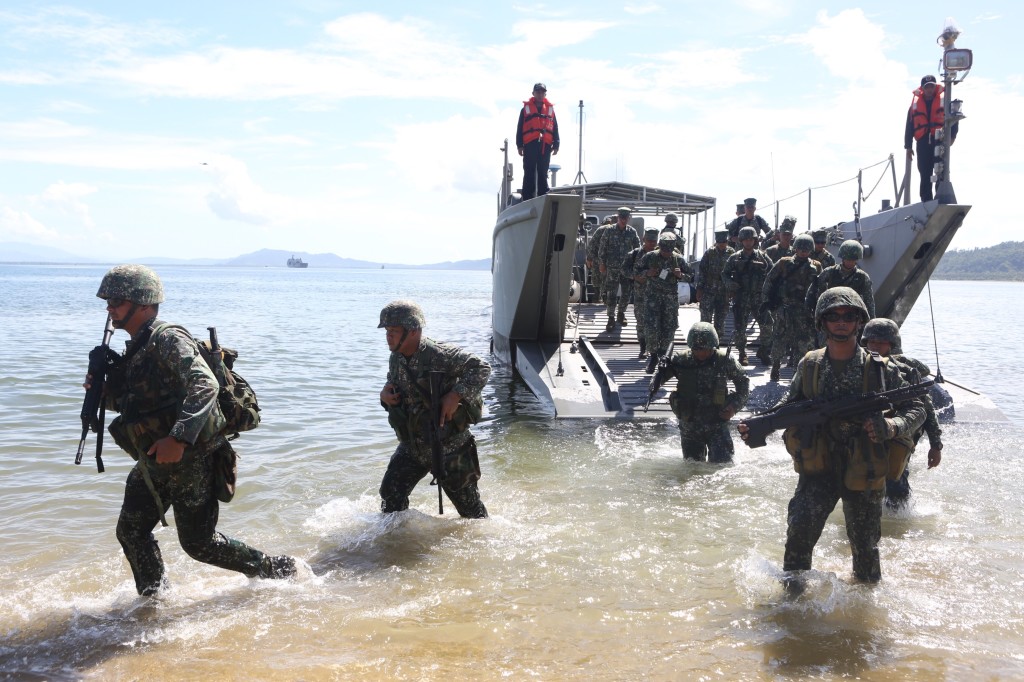Territorial defense takes a backseat as PH, US troops train for disaster response
[ventuno id=’OTM1MTQzfHwyMzY4fHwxMDg2fHwxLDIsMQ==’][/ventuno]
CASIGURAN, Philippines — Philippine and American troops and assets worked side-by-side in a simulation of relief operations of a super typhoon, highlighting the focus on humanitarian assistance and disaster response as the usual territorial defense took a back seat.
The shift of this year’s theme was upon the orders of President Rodrigo Duterte to focus on disaster response. He also wanted a rebalance of the country’s foreign policy.
The President wanted to become less dependent on United States, and has started to develop warmer ties with China and Russia, countries seen as rivals of the US. At one point, he even ordered to scrap the Balikatan but eventually softened his stance.
Other PH-US drills were scrapped — the Philippine Amphibious Landing Exercise (Phiblex) and Cooperation Afloat and Readiness Training (Carat), which focus on external and maritime security.
“We have revolving focus on Balikatan. But because it’s the desire of the commander-in-chief and the government focus on the more imminent threat, and what is that? The imminent threat of disaster happening in any part of the archipelago,” said Armed Forces of the Philippines spokesperson Brig. Gen. Restituto Padilla on the sidelines of the event.
“The military is always dictated by the guidance of political leaders and we comply with that. I believe the US can say the same way,” he also said.

Armed Forces of the Philippines and United States Marines conduct civil military activities from the sea during the Balikatan exercises in Casiguran, Aurora province, May 15, 2017.
INQUIRER PHOTO / NIÑO JESUS ORBETA
This year’s Balikatan only involved about 5,000 troops (2,800 Filipino and 2,600 American), compared to last year that involved around 9,000 American and Filipino soldiers combined. But Padilla denied that the Balikatan for this year was scaled down.
“We have not downsized. There were bigger forces last year because there were multiple events that involved four area commands. We are involving only two area commands, Central Command and Northern Luzon Command. That explains the involvement of forces,” he said.
Brig. Gen. John Jansen, commander of US Joint Task Force, said there was no direction to downsize the exercises.
“Nobody told us there had to be fewer people or there will be smaller exercise. It’s when the exercise objectives are laid out, taking political directions and negotiated at very senior level, four-star to four-star and we look up at those objectives….It turned out this Balikatan is a little smaller 2/3 of size compared to last year…but there is no policy that says that it will be small,” he said.
Typhoon scenario
Barangay Dibacong in Casiguran was chosen as this year’s venue of the main event for the joint drills, which was attended by senior Philippine and US military officials. The town was supposedly hit by a super typhoon and there was no other way to bring relief to residents but by air and sea. The typhoon’s strength was likened to Yolanda, a super typhoon that struck Eastern Visayas in 2013.
“Sometimes bringing relief from the sea is not the only way to save lives but the best way to save lives,” Jansen said.
The Philippine Navy’s biggest ship, the BRP Tarlac (LD-601) was utilized as a supply ship and ferried troops for the event dubbed as Civil Military Activities from the Sea. The Philippines also used its Huey helicopters for aerial reconnaissance.
The United States used its V-22 Osprey and UH-60 Black Hawk choppers for insertion of troops and air casualty evacuation. It also used the USNS Sacagaewa, a Lewis and Clark-class dry dock cargo ship, to ferry personnel and relief supplies.
The militaries of both countries also sponsored a medical and dental mission, and taught residents expedient water collection and purification, health and safety management and other topics related to calamities.
The Balikatan is part of a Mutual Defense Treaty between the two countries signed in 1951./ac